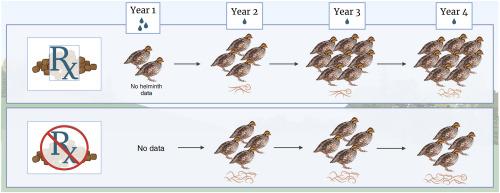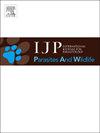俄克拉荷马州西部北部山齿鹑(Colinus virginianus)和两种寄生线虫种群对驱虫药补充饲料的反应
IF 2
3区 医学
Q3 ECOLOGY
International Journal for Parasitology-Parasites and Wildlife
Pub Date : 2024-10-11
DOI:10.1016/j.ijppaw.2024.101001
引用次数: 0
摘要
事实证明,蠕虫能够严重影响宿主的生存能力。这通常是通过服用驱虫药进行实验证明的,但很少在景观或宿主种群范围内进行。在这里,抗蠕虫药物芬苯达唑(Fenbendazole,FBZ)被混入补充饲料中,并提供给自由活动的北山鹑(Colinus virginianus)种群。对北斑鸠和两种常见的感染北斑鸠的线虫数量进行监测,并与邻近未接受治疗的种群进行比较。从2019年到2022年,接受药物饲料的北方白冠马种群数量大幅增长,而邻近地点的种群数量没有变化。在 2021 年和 2022 年,接受治疗的种群数量也大大超过了未接受治疗的种群数量。此外,经过处理的北部山齿白种群中两种线虫的数量也大大减少。这项研究提供了蠕虫种群能够对北方白熊种群产生负面影响的证据,并提出了一种在景观尺度上降低这些种群蠕虫丰度的方法。本文章由计算机程序翻译,如有差异,请以英文原文为准。

Response of Northern bobwhite (Colinus virginianus) and two parasitic nematode populations in western Oklahoma to anthelmintic supplemental feed
It has been demonstrated that helminths are capable of critically impacting the fitness of their hosts. This has typically been shown experimentally through the administration of anthelmintic drugs but are rarely performed on a landscape or host population scale. Here, the anthelmintic fenbendazole (FBZ) was mixed in a supplemental feed and provided to a free-ranging population of Northern bobwhite quail (Colinus virginianus). Abundances of Northern bobwhite and two nematode parasites commonly found infecting Northern bobwhite were monitored and compared to a neighboring untreated population. The Northern bobwhite population receiving the medicated feed grew substantially from 2019 to 2022, while the neighboring site had no change in abundance. The treated population was also substantially greater than the untreated population in 2021 and 2022. Additionally, the treated Northern bobwhite population had substantially lower abundances of the two nematodes. This research provides evidence of the ability of helminth populations to have a negative impact on Northern bobwhite populations and presents a method for reducing helminth abundance in those populations on a landscape scale.
求助全文
通过发布文献求助,成功后即可免费获取论文全文。
去求助
来源期刊

International Journal for Parasitology-Parasites and Wildlife
Medicine-Infectious Diseases
CiteScore
3.80
自引率
5.60%
发文量
113
审稿时长
45 days
期刊介绍:
The International Journal for Parasitology: Parasites and Wildlife (IJP-PAW) publishes the results of original research on parasites of all wildlife, invertebrate and vertebrate. This includes free-ranging, wild populations, as well as captive wildlife, semi-domesticated species (e.g. reindeer) and farmed populations of recently domesticated or wild-captured species (e.g. cultured fishes). Articles on all aspects of wildlife parasitology are welcomed including taxonomy, biodiversity and distribution, ecology and epidemiology, population biology and host-parasite relationships. The impact of parasites on the health and conservation of wildlife is seen as an important area covered by the journal especially the potential role of environmental factors, for example climate. Also important to the journal is ''one health'' and the nature of interactions between wildlife, people and domestic animals, including disease emergence and zoonoses.
 求助内容:
求助内容: 应助结果提醒方式:
应助结果提醒方式:


